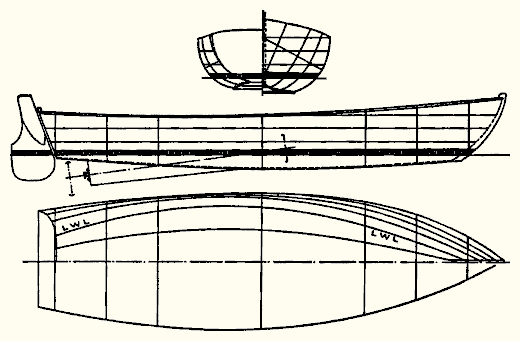
| Patsy A 16' 11" Modified Dory By William Atkin |
| A Sinple Little Boat | |
| There is a whole lot to be said for such a boat as this little Patsy. She is a very near relation to the dories made famous by the fisherfolk of the New England states, or getting down to cases, like the one in which Captain Andrews sailed single-handed from the waters of Massachusetts Bay to the shores of Europe. | |

| |
Patsy is a near relation, mind you; not the twin of a genuine banks dory. Because a banks dory would not make an especially desirable motor-propelled pleasure boat. The model as perfected for fishing is rather too narrow on the bottom, and the sides too straight. And, one might add, the sheer a bit too bold. But Patsy has the earmarks, the characteristics, and the ableness of the excellent small boats that are carried to sea on the decks of the fishing schooners that hail from Down East fishing ports. Modified, or developed, from a prototype famed for seaworthiness, our Patsy will provide an excellent kind of small open boat. Despite her modest dimensions she has room for four; mind you, though, four is the limit. She is, by the way, 16 feet 11 inches in overall length; the waterline length is 15 feet; breadth 5 feet; and draft under skeg, 1 foot 2 inches. The freeboard is ample, being 2 feet 2 inches at the bow, and 1 foot 6 inches at the stern. The sheer is enough for appearance without being bold; too much sheer is rather out of place in the design of a motor boat. With excessive sheer one must either have abnormally high ends, or insufficient freeboard amidships; both bad features in motor propelled craft. There is a happy medium in these matters and it is accomplished in the sheer line of Patsy. | |

| |
Tucking the motor, with its tank and electrical equipment, under the motor house as shown keeps the whole outfit dry, confines motor noises, prevents oil and grease from finding its way all over the boat, and strengthens the hull. The continuous deck beams either end of the motor house serve as panting beams and vibration dampeners. There is plenty of room under the house for muffler and exhaust piping. There is a hatch in top of the house which lifts off, and is also hinged in the center as shown. A pair of doors give access to the flywheel end of the motor. While a reverse gear may not be necessary, undoubtedly a one-way clutch has advantages and this equipment is so inexpensive that it is well worth having. The boat steers with a tiller; there is no better method, either. Tiller lines can be run around inside of the gunwales if desired, and then the boat can be handled from any position; use 1/4-inch diameter manila rope rove through plain galvanized blocks. No wheel or lever will be necessary. | |

| |
The topsides are rounded as shown which adds stability to say nothing of beauty to the little boat. There is generous flare, and this coupled with the lapped planking, will keep the boat dry and buoyant. The bottom board is flat across; but has considerable rocker fore and aft. The skeg is attached to the outside of the bottom board. The construction of this kind of boat is without complication and therefore will appeal to amateur builders. It is not the easiest thing in the world to build a boat; not even a small flat bottomed boat; some skill is required, and lots of energy, and lots of spare time, and more than ordinary common sense and ingenuity, the latter being the most important of the lot. It is perfectly useless to overpower a boat of this model. Two to eight horsepower is ample. Perhaps it would be best, if not ideal, to install a motor of the single cylinder type of 5 h.p. Here will be power enough for. a speed of close to 7 1/2 miles an hour. The initial cost of the motor and its equipment will be little, and the satisfaction viewed from every angle big. | |
 PHOTOS OF PATSY PHOTOS OF PATSY 
| |
| Plans for Patsy are $100 MYSTIC SEAPORT MUSEUM SHIPS PLANS STORE https://store.mysticseaport.org/ships-plans/ shipsplanstore@mysticseaport.org
+1 (860) 572 5360 | |
| BACK TO PLAN LIST | |